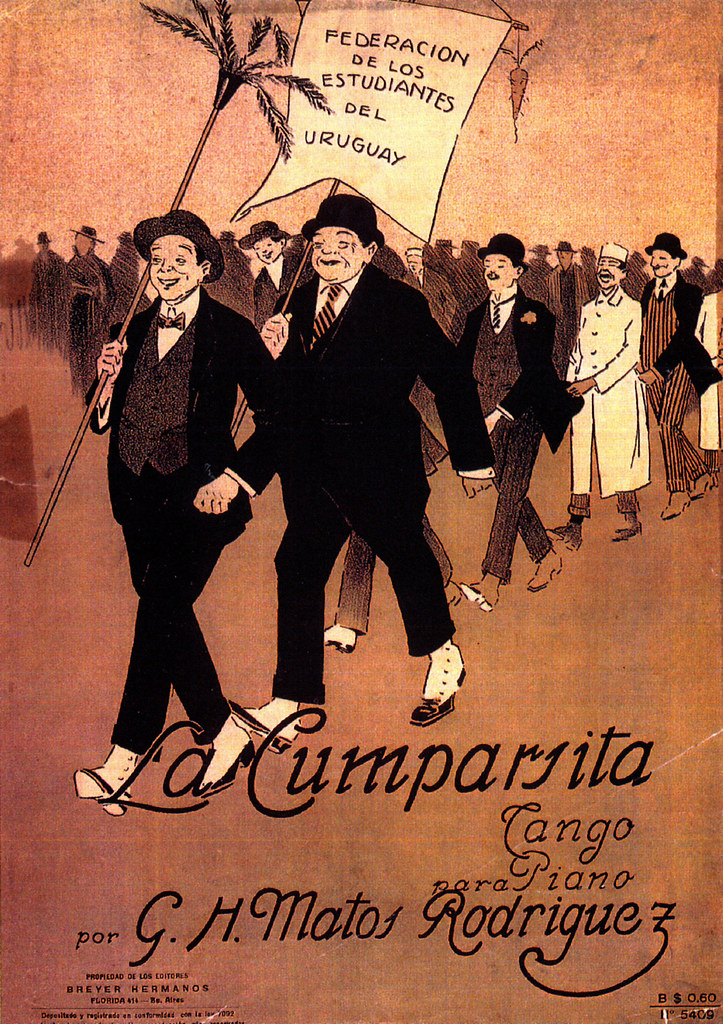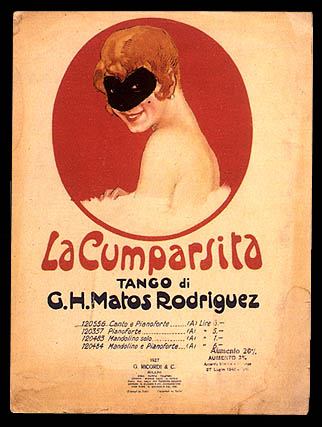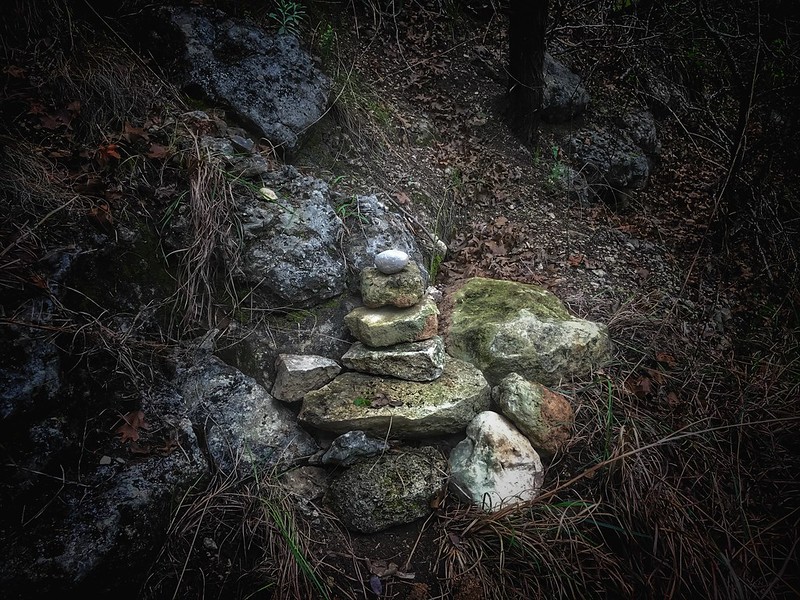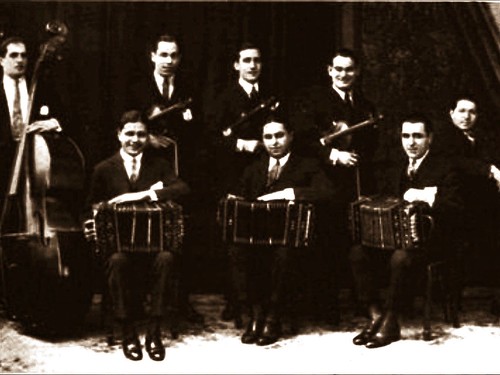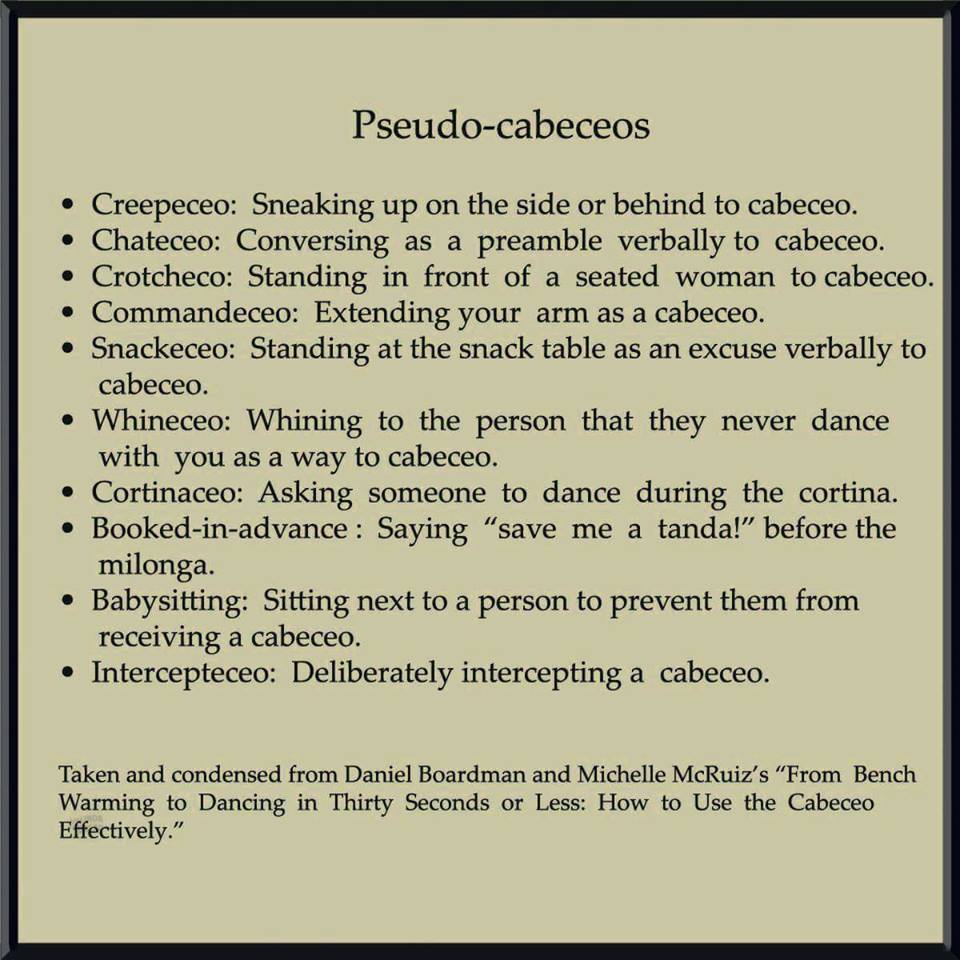By
Michael Lavocah
Adapted by the author from Tango Stories: Musical Secrets, 2nd edition, milonga press, 2014.
http://www.milongapress.com/books/tango-stories/english/
Listening to tango dance music - A beginner’s guide
hen listening to tango music for the first time, especially if our main experience of music has been modern pop music, it can be difficult to hear what is going on, and what we hear may well seem like a “wall of sound”. The good news is that listening to music is a faculty that we can develop. Attentive listening immediately changes our experience, making it richer, creating a relationship to the music. If you are a dancer, you dance what you hear, and so what you dance will immediately begin to change as well, without learning any new steps.
1. The four elements
Dance music can be thought of as comprising four elements: beat (compás), rhythm, melody, and lyrics. Lyrics are optional, although there are always feelings. The first step in developing our listening faculty is to learn to listen to these four elements. These form four listening skills, which for the dancer will map to four dancing skills —the skills of dancing to the beat, to the rhythm, to the melody, and to the lyrics—.
Beat and rhythm are not the same. By beat we mean the regular pulse of the music. Beat alone is not music, but it is the foundation of music. We walk on the beats, and so without beat there is no walking dance. Beat is a natural, physical phenomenon, like the beat of your heart, or the cadence of walking, or breathing. Some people think of themselves as having «no sense of rhythm», but the beat is there within us, waiting to be discovered.
Beat and rhythm are connected, and it’s hard to find a tango that is pure beat (i.e. with no rhythmic variation), but there is one: Juan D'Arienzo’s “Nueve de julio” —curiously, and significantly, the breakthrough track for the new D’Arienzo sound— that was created by the arrival of Rodolfo Biagi in 1935.
By rhythm, as distinct from beat, we mean the changing pattern of the beats. A classic example is the opening of “Milongueando en el cuarenta”, recorded by Aníbal Troilo in 1941, with its tumbling syncopation: 1-2-3, 1-2-3, 1-2-3, 1-2-3, 1-2, 1-2, 1.
Orquesta Troilo
The melody is what we sing to ourselves, or to others, when we recall a song: the tune. The more romantic orchestras prioritise the melody over the beat and the rhythm. This is something we hear developing in the later recordings of Di Sarli. For an earlier example, we can turn to Lucio Demare’s iconic 1942 recording of “Malena”, his own composition. The melodic line is vigorous and clear, and thus easy to follow.
Finally we have the lyrics – meaning. This element is hidden if we don’t speak Spanish. As an example, let’s take Ada Falcón’s 1940 recording of “Te quiero” (“I love you”) with the orchestra of Francisco Canaro. The opening lines run:
I love you!
As no-one has ever loved you,
and no-one ever will;
I adore you!
As one adores the woman
one has to love…
Hearing these words is sure to change your relationship to the song, and to arouse feelings, perhaps memories, which can then become enfolded into the music and expressed in your dancing.
The tango orchestras mix and prioritise these elements differently and this is one way to feel the orchestras and to distinguish them.
The beat
Beats are not all the same —they have their qualities—, and each orchestra has a different quality to its beat. A first attempt to discern and feel these qualities would be to classify them into polar opposites: hard or soft, strong or weak, sharp and choppy (staccato) or rounded and smooth (legato). D’Arienzo’s beat is staccato, a development that reaches its zenith with Biagi (e.g. the extreme beat of “Racing Club”); whilst Caló’s beat is smooth and soft (“Al compás del corazón (Late un corazón)”). Troilo is more sophisticated, moving between staccato and legato (“Milongueando en el cuarenta”, 1941).
This analysis breaks down when one starts listening to music from before the golden decade. The beats of Roberto Firpo (“La eterna milonga [b]”, 1929) or Juan Maglio (“Sábado ingles”, 1928) are strong, but also soft. In this period, most of the orchestras made a prominent use of the arrastre in their music. Now, what is the arrastre? It is when the beat, instead of being something instantaneous, is made longer, starting quietly and accelerating to a crescendo. In tango, this is described by the sound zhum (written: yum). This effect can be produced on all the instruments within the orchestra. In the bandoneon, it is produced by keying the note before opening the bellows, and then accelerating the opening to a sudden stop: listen for instance to the opening of “Melancólico”. In the strings, the bow is placed on the string before it is moved, and then accelerated. If you are not used to listening for this, it’s easiest to start with the double bass rather than the violins, for instance in the opening of Piazzolla’s “Buenos Aires hora cero”. From the point of view of walking, the most important of the string instruments is the double bass, because it’s the low notes which produce the beats upon which we walk. When going on to listen to the violins, the opening chord of Di Sarli’s “Retirao” provides an exaggerated example.
When the whole orchestra joins in, the effect can be dramatic. My favourite example is a recording by Osvaldo Fresedo’s sextet, “Mamá… cuco” (1927). This reveals another side to Fresedo, full of bite. The arrastre would not be so prominent again until Osvaldo Pugliese incorporated it into what he called la yum-ba: the repeated cell of two strong arrastres (‘yum’) on beats 1 and 3, separated by a less powerful chord on beats 2 and 4 (‘ba’), supported by the double bass powerfully striking the strings with the bow.
The qualities of the beat will affect the quality of the walk. Dancing to different orchestras is not principally about choosing different figures for different kinds of music, although we might: it is about manner. The different qualities of beat inspire different qualities of walking —different ways to place out feet upon the floor—. The arrastre in particular can have a big impact on the way the weight is transferred across the foot.
Rhythm and syncopation
The main rhythmic devices in tango are syncopations —beats falling in unexpected places—.
Let’s start with D’Arienzo. Principally, he uses the syncopa, tango’s classic syncopation – in Western terms, the behind-the-beat syncopation: listen for instance to the first syncopations in “Don Juan (El taita del barrio)” (1936). For a dancer, the staccato acceleration of the syncopa is strongly suggestive of a corte, a cut step. These syncopations often occur in bursts of three —useful information for the dancer—.
Listen closely, and you’ll hear that each syncopation is actually a double syncopation – a behind-the beat syncopation followed by a different one, a before-the-beat syncopation. This is normally much quieter, so we don’t notice it, but when equal prominence is given to both, the result can be disconcerting, as in the opening beats of D’Arienzo’s “Homero” (1937). You can also hear this combination at the opening of all three of Di Sarli’s recordings of “Organito de la tarde”.
Another classic syncopation is the 3-3-2 syncopation (counting 8 beats as 1-2-3, 1-2-3, 1-2). In tango’s golden age, this is found only in the more sophisticated orchestras. Strong examples are Pedro Laurenz’s “Arrabal” (1937) and Troilo’s “Comme il faut” (1938) —both of them electrifying recordings—.
An even more sophisticated and unique example, which we might consider derived from the 3-3-2, is the tumbling syncopation that Troilo employs at the opening of “Milongueando en el cuarenta” (1941). Counting it out, we find that it runs: 3-3-3-3-2-2-1.
The melody
Melody is constructed in phrases, just like human speech. Phrases can be short or long. In the very early days of tango, the days of the 2x4, phrases were always short: think for instance of “El choclo” —but this would soon change—. The example par excellence of the long phrase in tango music occurs in Francisco De Caro’s “Flores negras” (1927), one of the most beautiful melodies ever written in tango. It’s also an excellent example of counterpoint: listen carefully to the opening phrases, and underneath the nasal tones of Julio De Caro’s cornet violin one can hear the second violin playing a completely different tune.
The lyrics
It’s beyond the scope of this essay to talk about lyrics in any depth, but it’s worth noting that in the golden decade, sad lyrics were often given a very bright treatment by the dance orchestras —just think for instance of Troilo’s “Toda mi vida” (1941)—. This creates a bittersweet quality, which is perhaps no accident. If you want to appreciate this, there is no alternative but to learn Spanish.
Mixing the four elements
Generally speaking, dance orchestras lean towards a treatment that favours either the beat and the rhythm (D'Arienzo), or the melody (late Di Sarli). When both aspects are given space, the results are very satisfying: think for instance of Ricardo Tanturi with Enrique Campos, or Ángel D'Agostino with Ángel Vargas.
2. The instruments
Having looked briefly at the way the orchestras treat the elements of beat, rhythm and melody, we can go look at the way they use the instrumental forces at their disposal: the bandoneons, the violins, and the piano. How much prominence is each section given? In the case of the bandoneons and the violins, are individual players given solos? If they are, is there something characteristic about their playing which allows us to enjoy and to identify individual musicians?
The D'Arienzo orchestra always had a terrific bandoneon section, and many pieces culminate in a variación showcasing the ability of the whole group. A classic early example, with very clear phrasing, is the variación in “Paciencia” (1937). Listen closely and you may also hear the delightful changes in rhythm (from 4 beats per note to 3) that D’Arienzo often employs in his variaciones.
The Troilo orchestra has a completely different way of using the bandoneons. Rather than featuring the whole section, Troilo’s solo playing is given space. Troilo was famous for the feeling he put into his playing, and on many occasions he makes music just on a single note: the supreme example is his solo at the end of the milonga “Del tiempo guapo”. His rather more famous solos in “La tablada” (1942) and “La cumparsita” (1944) also use very few notes, but feel more economical and modest, with a subtle, introverted feeling.
Another way of using the bandoneon is shown by fellow bandoneonista Pedro Laurenz. His orchestra makes use of running variations, in which the bandoneon doesn’t pause for breath. The bandoneon is bisonic: each button produces two different notes according to whether the instrument is being opened or closed. It’s easier to play the instrument with power when opening, because, with the help of gravity, the instrument falls open across your knee. For this reason, many players mostly play in the opening direction, and then quickly close the instrument in order to return to that opening direction. Laurenz, on the other hand, just keeps going – listen to any of his orchestra’s recordings from 1940, such as “No me extraña”. This is virtuoso playing, requiring a total technical mastery of the instrument.
There are other bandoneon players whose sound we can identify. Osvaldo Ruggiero, Pugliese’s first bandoneon for 24 years, can be immediately identified by the piercing, sharp sounds he produces, for instance, in the 1944 recording of “Recuerdo” —the facility with which he dashes off the final variación makes it sound quite effortless—. One doesn’t realise how difficult it is until one hears it attempted by any other player.
Another bandoneonista with an individual sound is Minotto Di Cicco, Canaro’s first bandoneon for many years. Minotto was a real student of the instrument, producing chords with a wide spread of notes whilst always maintaining a very clean fingering. A good example of this can be found in “La muchachada del centro” from 1932.
The violins
The violin was a tango instrument from the very beginning, and there are a few orchestras which favoured the violins over the bandoneons. The classic example is the orchestra of Carlos Di Sarli. A useful listening example is the 1940 recording of the instrumental “El Pollo Ricardo”. Given the year of the recording (still in the aftermath of the D'Arienzo explosion) the playing is staccato and up-tempo, but the music is easily identified as Di Sarli from the piano playing. In the first chorus, the bandoneons are used to support the sharp attack in the string sections.
An even sharper attack can be heard from the violin of Raúl Kaplún, who joined Lucio Demare in 1942. This added strength to Demare’s lyrical sound, a combination you can hear from the opening notes of “Sorbos amargos”.
Another orchestra with a muscular violin sound, although with a denser texture, is Tanturi during his years with Campos on vocals. The classic example is “Oigo tu voz”, in which the violin opens the piece.
D'Arienzo’s violin rejects all these possibilities, and returns to the violin obligato of the guardia vieja: not really a melody, but a simple line, played low on the fourth string, which threads its way through the music. You can hear it for instance in the closing passage of his first (1937) recording of “La cumparsita” —or just about anywhere in his music—.
The piano
The use of the piano within the orchestra shows huge variation, perhaps more than with the other instruments. In some sense, it is the axis, the spine of the orchestra. Its role can be restricted to accompaniment, as in Tanturi (e.g. “Pocas palabras”), but the great orchestras did more with it. The piano often appears in the gaps between phrases, where it has different functions. Sometimes, especially in valses, it links the phrases together, e.g. Osmar Maderna’s piano for Miguel Caló in “Bajo un cielo de estrellas”. Sometimes it punctuates the phrases, as with Biagi in D'Arienzo’s orchestra, e.g. “El choclo”. D'Arienzo’s piano is usually heard quite high on the keyboard: the marcato of his bandoneons is so strong that his pianists, unusually, do not need to do much work in the bass notes.
Di Sarli’s piano is also easiest to notice in the spaces between phrases, where he places delicate, bell-like trills, but the real action is going on in his left-hand. A good example is his version of “La cachila”, and not just because it contains a rare piano solo. Di Sarli recorded this twice, in 1941 and 1952. The two versions are quite different in the piano; both are good, but Di Sarli’s growling left-hand is easier to appreciate in the second version.
Finally we come to tango’s most brilliant improvising pianist, Orlando Goñi, a man whose contribution to the Troilo orchestra has not really received the recognition it deserves. Naturally, he shines most in the instrumentals. “C.T.V.” gives you a good idea of what he is capable of: he roams all over the keyboard with great freedom. In the right hand, he can imitate and reflect the phrasing of Troilo, as in the opening notes of “La tablada”; in the left-hand (the bass notes), his legendary marcación bordoneada —striking of a chord as though rolling up through the bass strings of a guitar— provides a fluid and elastic foundation to the rhythmic drive of the orchestra that has never been equalled.
The double bass
The bass notes of the orchestra give the walking impulse, and these come from the left hand of the piano and the double bass, which had to work together in the orchestras: the double bass was usually positioned very close to the piano. Today we mostly listen to tango music on recordings, on which these notes are not as loud as they are in real life. In addition, the sound system in the average milonga does not reproduce these notes very well, so we need to make a special effort to train our ears to listen for them. Most pop music has some kind of bass drive; the tango of the golden age was simply the popular music of its day, albeit some of the most sophisticated pop music the world has ever known.
For the dancer, being aware of both the beat/rhythm and the melody, and being able to separate them in our ear, expands the range of music that we enjoy and gives us freedom. In tango music, the melody is often given a rhythmic treatment. It’s often impossible to separate them entirely, but learning to discriminate between the melody and the rhythm is one of the most important skills of all.
Adapted by the author from Tango Stories: Musical Secrets, 2nd edition, milonga press, 2014.





